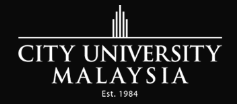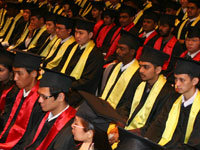The Malaysian Higher Education System - An Overview
by StudyMalaysia.com on March 14, 2022 | Higher Education in Malaysia, The National Education System
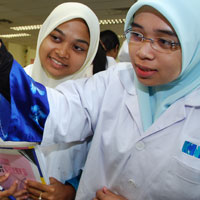
Higher Education in Malaysia
A Snapshot of Higher Education Institutions
in Malaysia
The higher education sector is responsible for the operation of
higher education institutions (HEIs) in Malaysia and is under the
jurisdiction of the Ministry of Higher Education (MOHE).
The education sector has always enjoyed the highest national
development budget which symbolises the commitment of the
Malaysian government towards education.
Malaysia's HEIs (i.e. public universities, private higher educational institutions, polytechnics and community colleges) housed more than a million students in 2011, of which about 93,000 were international students from more than 100 countries. In contrast, there were about 89,686 Malaysian students (27,003 receiving sponsorship and 62,683 self-funded) who were studying overseas in 2011.
With a multi-ethnic population of about 28.3 million, Malaysia had 20 public universities, 50 private universities and six foreign university branch campuses; 403 active private colleges, 30 polytechnics and 73 public community colleges in 2011. These HEIs offer a wide range of tertiary qualifications at affordable prices.
There are also various HEIs from the UK, the US, Australia, Canada, France, and New Zealand which offer twinning and '3+0' degree programmes through partnerships with Malaysian private higher education institutions. At present, some world-class universities such as RMIT University, Johns Hopkins University School of Medicine and the Royal College of Surgeons, Ireland have established their collaboration with the local PHEIs.
Five of the 20 public universities in Malaysia have been assigned research university status with additional funding for R&D and commercialisation of research. The remaining 15 public universities have been categorised as either comprehensive or focus universities. In the 2012 new year's speech, the Minister of Higher Education announced that five public universities have been given autonomy in administration, human resources, financial and academic management and student intake. They are Universiti Malaya, Universiti Kebangsaan Malaysia, Universiti Sains Malaysia, Universiti Putra Malaysia and Universiti Teknologi Malaysia. This move is aimed at encouraging excellence among local institutions of higher learning.
The quality of higher education is assured through the Malaysian Qualifications Agency (MQA) which undertakes the implementation of the Malaysian Qualifications Framework. MQA is also responsible for quality assurance and the accreditation of courses and other related functions, covering both public and private higher educational institutions.
The provision of higher education is well regulated. Below are some of the legislation :
- The Education Act 1996 (Act 550)
- The Private Higher Educational Institutions Act, 1996 (amended 2009)
- The National Council of Higher Education Act, 1996
- Malaysian Qualifications Agency Act 2007 (replacing the previous namely National Accreditation Board Act 1996 which has been repealed)
- The Universities and University Colleges (Amendment) Act, 1996 (amended 2009)
- The National Higher Education Fund Corporation Act, 1997 (Amendment 2000)
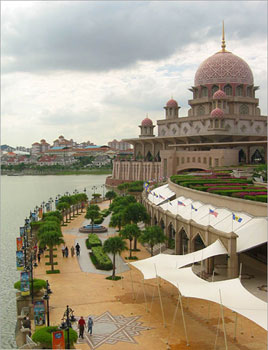 Both the Universities and University Colleges Act and the Private Higher Educational Institutions Act are currently under review.
Both the Universities and University Colleges Act and the Private Higher Educational Institutions Act are currently under review.
The internationalisation of the higher education sector is a high priority for MOHE. Efforts have been made to improve the world ranking of Malaysian universities; to have 150,000 international students by 2015; to create more 'Malaysian Chairs' at universities abroad; and to collaborate and cooperate with world-renowned universities on research and academic matters.
The government will continue to create a friendly environment and invite more world-class foreign university branch campuses or faculties to be set up in Malaysia. Currently, there are six foreign universities with branch campuses in Malaysia. They are Monash University (Australia), The University of Nottingham (UK), Curtin University (Australia), Swinburne University of Technology (Australia), Newcastle University School of Medicine (UK) and University of Southampton (UK).
Other initiatives undertaken by HEIs include the establishment of Malaysian university branch campuses in other countries and increasing transnational education collaboration with overseas institutions. Malaysian higher education is also aggressively promoted in many parts of the world through road-shows.
MOHE also aims to have 20 Research Excellent Centres which are of international standard by 2020. The nation has also targeted to achieve 100 researchers, scientists and engineers (RSE) per 100,000 workforce by the year 2020. The 10MP (2011-2015) sets to improve the quality of academic staff by increasing the number of academics with PhDs in public universities, with a target of 75 per cent in research universities and 60 per cent in other public universities. To achieve this target, the implementation of the MyBrain15 programme will be intensified to finance doctoral studies for the purpose of increasing the number of PhD holders to 18,000 by 2015.
Malaysia's first rating system, SETARA (Rating System for Higher Education Institutions in Malaysia) was implemented in 2009 to measure the performance of undergraduate teaching and learning in universities and university colleges in Malaysia. The SETARA result was measured using a six-tier category with Tier 6 identified as Outstanding and Tier 1 as Weak.
Subsequently, another rating system was introduced in 2011. My QUEST (Malaysian Quality Evaluation System for Private Colleges) was used to evaluate private colleges in Malaysia in terms of the quality of students, programmes, graduates, resources and governance. The MyQUEST rating categorised an institution as either excellent, good, or weak. The institutions would also receive a rating based on their level of achievement which ranged from 1 star (poor) to 6 stars (excellent).
These two rating systems serve as a reliable reference for students and parents in their selection of institutions and programmes of study offered by various HEIs.
Governing Authority for Higher Education - MOHE
The higher education sector is under the jurisdiction of the Ministry of Higher Education (MOHE). The establishment of this ministry on 27 March 2004 was a result of the re-structuring of the Ministry of Education and marked an important part of history in Malaysia, particularly in the development and expansion of the higher education sector. The establishment of MOHE is in line with the vision of the government in making Malaysia a centre of educational excellence and internationalising Malaysian education.
MOHE is the governing authority for the Malaysian higher education sector. It oversees HEIs (both public universities and private higher educational institutions), community colleges, polytechnics and other government agencies involved in higher education activities such as the Malaysian Qualifications Agency, the National Higher Education Fund Corporation (Perbadanan Tabung Pendidikan Tinggi Nasional – PTPTN), the Tunku Abdul Rahman Foundation (Yayasan Tunku Abdul Rahman) and others.
MOHE's Vision
To make Malaysia a centre of higher education excellence by the
year 2020
MOHE's Mission
To build and create a higher education environment that is
conducive for the development of academic and institutional
excellence and to generate individuals who are competent,
innovative and of noble character to serve the needs of the nation and the world.
Functions of MOHE
Some of MOHE's key functions include :
- Determining policies and the direction of the higher education sector in order to build an excellent and outstanding nation that is rich in knowledge, culture and civilisation
- Acting as a catalyst to develop the sector that enables the nation to compete in the era of globalisation
- Dealing with the challenges of the present global economic scene, in line with the government's aspiration to produce adequate human resource with knowledge and high moral values (National Higher Education Strategic Plan and Vision 2020).
Five Core Thrusts
MOHE has its focus on five core thrusts :
- To create a strategic and systematic plan for higher education
- To reinforce the management system of higher education
- To increase the level of capacity, accessibility and participation in higher education
- To enhance the quality of higher education at par with international standards
- To internationalise Malaysian higher education
Structure of MOHE
MOHE comprises four departments / sectors :
- The Department of Higher Education
- The Department of Polytechnic Education
- The Department Community College Education
- The Management Sector
- The Development Sector
The Department of Higher Education
The Department of Higher Education or popularly known as
Jabatan Pengajian Tinggi was restructured and established on 27 March 2004 in line with the creation of the Ministry of Higher
Education. The first restructuring exercise of this department was under the Ministry of Education on 1 October 1995.
The Department of Higher Education is supported by several sectors, divisions and an administrative unit that is responsible for the development of both public and private higher education in Malaysia. It also ensures that the universities and colleges are of international standing. This Department is also involved in the marketing of Malaysian higher education internationally as well as being in charge of international students' welfare.
The sector designated with the jurisdiction over public higher education is known as the 'Sector of Public Higher Education anagement' while the sector designated with the jurisdiction over private higher education is known as the 'Sector of Private Higher Education Management'.
Department of Polytechnic Education
The formation of the Department of Polytechnic Education was a result of a restructuring exercise by the Department of Polytechnic and Community College Education (DPCCE) on 16 September 2009.
The Department of Polytechnic Education has been entrusted to produce a generation of well-educated, skilled, creative, innovative, progressive and critical thinking youths who are highly employable.
Apart from public universities, polytechnic education offers an alternative route for school leavers with SPM qualifications to further their education at diploma and advanced diploma levels.
Polytechnic education is currently under major transformation with the aim of producing highly skilled graduates in line with the National Higher Education Strategic Plan (PSPTN) and the National Key Result Areas (NKRA). Polytechnics provide an alternative route that sufficiently produces highly skilled and qualified human capital which will ensure the success of a new economy based on innovation and creativity.
Department of Community College Education
The re-organisation of the Department of Polytechnic and
Community College of the Ministry of Higher Education in 2009
has given rise to the birth of the Department of Community College Education (or better known as JPKK). Its mission is to increase the socio-economic status of all levels of Malaysians through better access to education. This will be carried out through training programmes and the use of a life-long learning approach.
JPKK is tasked with providing vocational-based training (programmes such as Sijil Modular Kebangssan) leading to a certificate qualification for those who do not opt for the academic pathway. JPKK has taken aggressive measures to increase the student enrolment at TEVT and enhance the overall training quality of up-skilling and re-skilling programmes for the workforce involved in vocational fields.
 Management Sector
Management Sector
This is the corporate and management services sector. It consists of the Information Technology Division, Human Resource Management Division, Human Development and Training Division as well as the Finance Division. Overall, this sector handles the administration, corporate image and other management functions of the ministry.
Development Sector
The Development Sector consists of the International Division,
Planning and Research Division and Scholarship Division. Its
many functions include preparing physical development plans
that cover the five-year Malaysia Plan, facilities of public higher
educational institutions as well as polytechnics and community
colleges. It also handles the finances for managing and developing public higher educational institutions besides making monthly or quarterly and half-yearly reports.
Higher Education Legislation
The legal regulatory frameworks that govern the provision of higher education in Malaysia are :
- The Education Act 1996
- The Private Higher Educational Institutions Act 1996
- The National Council of Higher Education Act 1996
- Malaysian Qualifications Agency Act 2007 (replacing the previous namely National Accreditation Board Act 1996 which has been repealed)
- The Universities and University Colleges (Amendment) Act 1996
- The National Higher Education Fund Corporation Act 1997
- The National Higher Education Fund Corporation (amendment) Act 2000
- Private Higher Educational Institutions (Amendment) Act 2009
- Akta Universiti dan Kolej Universiti Pindaan 2009
The Education Act 1996 (Act 550)
The Education Act 1996 covers pre-tertiary levels of education
under the national education system which comprises preschool,
primary, and secondary education as well as post-secondary
education.
This Act contains some provisions that apply to the Ministry of Higher Education in the establishment of polytechnics and community colleges. The Private Higher Educational Institutions Act, 1996 & Act 2009 (amendment) This Act governs the establishment and operations of private higher educational institutions. It also makes provision for the establishment of private universities, university colleges, branch campuses of foreign universities as well as the upgrading of existing private colleges to universities.
In addition, the Act enables the liberalisation of higher education in the country to meet the increasing demand for tertiary education and a highly-educated and skilled workforce.
The National Council on
Higher Education Act, 1996
Under this Act, a national body was set up to determine policies
and co-ordinate the development and rapid expansion of tertiary education in the country.
Malaysian Qualifications Agency Act, 2007
(replacing the National Accreditation Board Act 1996 which has
been repealed)
The Malaysian Qualifications Agency Act, 2007 paves the way for the establishment of the Malaysian Qualifications Agency as a national quality assurance agency to implement the Malaysian Qualifications Framework (MQF), accrediting higher education programmes and regulating the quality and standard of higher education providers of both public and private higher educational institutions in the country.
The Universities and University Colleges (Amendment) Act, 1996 & Act 2009 (amendment)
This Act seeks to corporatise the management and administration
of public universities. With corporatisation, these universities are
given more administrative and financial autonomy to chart programmes necessary for academic excellence.
The National Higher Education Fund Corporation Act, 1997
The purpose of this Act is to establish a fund that provides financial assistance through study loans to students at higher educational institutions in Malaysia. It also provides for the establishment of a savings scheme with the objective of instilling saving habits in children, from as early as Year 1 in primary school, with the intention of enabling them to finance their own higher education in future.
All higher educational institutions operating in Malaysia are subjected to one or more of the above legislation, depending on whether the education provider is publicly or privately-owned.
The legislation has made possible the following major enhancements in the Malaysian higher education system :
- the provision for the establishment of privately-run universities and systematic expansion of private education at tertiary level
- the provision for fines and jail term on operators who have flouted the provisions of the laws
- the provision for setting up of a quality assurance agency by the government to implement the Malaysian Qualification Framework as a basis for quality assurance in higher education and also as a reference standard for national qualifications
- the allowance for greater administrative and financial autonomy of public universities
- the establishment of student loans for greater access to higher education
The above Acts are reviewed from time to time to ensure that Malaysia achieves its aim of becoming a centre of educational excellence.
Medium of Instruction
English is used as the primary medium of instruction at most of the private higher educational institutions in the country. It is however, only used for postgraduate studies at public universities as the bachelor degree courses conducted at these universities are taught primarily in the national language, Bahasa Melayu.
Providers of Higher Education
Introduction
Both public and private education providers play equally important roles in the provision of higher education. Together, the public and private sectors provide abundant study options. HEIs offer programmes leading to the award of certificates, diplomas as well
as postgraduate qualifications.
Higher education providers in Malaysia can be grouped into two major categories :
- Public higher educational institutions (government funded),
which consist of :
- Public universities
- Polytechnics
- Community colleges - Private higher educational institutions, which consist of :
- Private universities
- Private university-colleges
- Foreign university branch campuses
- Private colleges
Public Higher Educational Institutions
The government-funded (public) higher educational institutions
under the Ministry of Higher Education consist of :
- public universities which offer bachelor degrees and postgraduate programmes, with some offering programmes at diploma level and university foundation programmes
- polytechnics and community colleges which offer certificate and diploma level programmes
- public colleges which offer certificate and diploma level programmes
Public Universities
Note: Public universities can be divided into five research universities, 11 comprehensive universities and four specialised technical universities (MTUN). The five public universities that have been designated as research universities are Universiti Malaya (UM), Universiti Putra Malaysia (UPM), Universiti Kebangsaan Malaysia (UKM), Universiti Sains Malaysia (USM) and Universiti Teknologi Malaysia (UTM). USM has also been awarded Apex university status.. The four universities under the Malaysian Technical University Network (MTUN) are UTHM, UTeM, UMP and UniMAP.
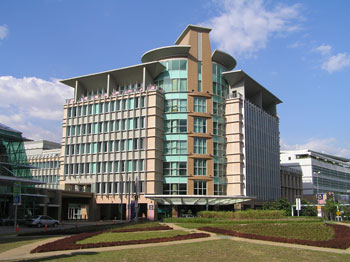 At the beginning of 2012, five research universities (i.e. UM, UKM,
USM, UPM and UTM) were conferred autonomy by the Minister of
Higher Education to act with full accountability and responsibility
on matters related to administration, academic management,
student intake, institutional governance, finance and human
resource management.
At the beginning of 2012, five research universities (i.e. UM, UKM,
USM, UPM and UTM) were conferred autonomy by the Minister of
Higher Education to act with full accountability and responsibility
on matters related to administration, academic management,
student intake, institutional governance, finance and human
resource management.
With this autonomy, the Board of Directors of these universities would now be empowered to make decisions that were once decided by MOHE. However, the performance of these five universities would be audited to ensure that the integrity and accountability of the universities would be kept in check under the Code of University Good Governance (CUGG) and University Good Governance Index (UGGI).
In terms of student intake, these five universities are given preference to select from UPU (BPKP)'s list of applicants with Sijil Pelajaran Malaysia (SPM) and Sijil Tinggi Persekolahan Malaysia (STPM) certificates.
Polytechnics and Community Colleges
• 36 polytechnics and 104 community colleges in the country
Teacher Education Institutes
(this category is under the jurisdiction of Ministry of Education)
• 27 teacher education institutes
Private Higher Educational Institutions
All private-funded higher educational institutions come under the jurisdiction of the Ministry of Higher Education and comprise :
- Private universities, which award their own degree qualifications, diploma and foundation studies
- Private university-colleges, which award their own degree qualifications, diploma and foundation studies
- Foreign university branch campuses, which award their own degree qualifications, diploma and foundation studies
- Private colleges, which award their own qualifications at diploma and certificate levels as well as 3+0 degrees, split-degrees and tutorial support for professional qualifications
Private Universities
ist of 50 Private Universities in Malaysia (as at December 2021)
| No. | Name of university | Date established | Location |
|---|---|---|---|
| 1 | Multimedia University (MMU), Cyberjaya | established in 1997 | Cyberjaya / Melaka / Johor |
| 2 | Universiti Tenaga Nasional (UNITEN) | established in 1999 | Putrajaya / Pahang |
| 3 | Universiti Tun Abdul Razak (UniRAZAK) | established in 1999 | Selangor |
| 4 | Universiti Teknologi Petronas (UTP) | established in 1999 | Selangor |
| 5 | International Medical University (IMU) | established in 1999 | Kuala Lumpur |
| 6 | Universiti Selangor (UNISEL) | established in 2000 | Selangor (Shah Alam and Bestari Jaya) |
| 7 | Open University Malaysia (OUM) | established in 2000 | Kuala Lumpur |
| 8 | Malaysia University of Science & Technology (MUST) | established in 2000 | Selangor |
| 9 | AIMST University | established in 2001 | Kedah |
| 10 | Universiti Tunku Abdul Rahman (UTAR) | established in 2002 | Selangor / Perak |
| 11 | Universiti Kuala Lumpur (UniKL) | established in 2001 | 11 campuses located in Kuala Lumpur and around the country |
| 12 | Wawasan Open University | established in 2006 | Penang |
| 13 | Albukhary International University | established in 2006 | Kedah |
| 14 | Al-Madinah International University (MEDIU) | established in 2006 | Selangor |
| 15 | International Centre for Education in Islamic Finance (INCEIF) | established in 2006 | Kuala Lumpur |
| 16 | Limkokwing University of Creative Technology | upgraded to university college in 2003, and further upgraded to full university status in 2007 | Putrajaya / Melaka |
| 17 | Management and Science University (MSU) | formerly KUTPM which was established in 2001 and upgraded to full university in 2007 | Selangor |
| 18 | Asia e University (AeU) | established in 2007 | Kuala Lumpur |
| 19 | UCSI University | upgraded to university college in 2003 and further upgraded to full university status in 2008 | Kuala Lumpur / Terengganu / Sarawak |
| 20 | Quest International University | established in 2009 | Perak |
| 21 | INTI International University (IIU) | upgraded to university college in 2006 and further upgraded to full university status in 2010 | Negeri Sembilan |
| 22 | Taylor’s University | upgraded to university college in 2006 and further upgraded to full university status in 2010 | Selangor |
| 23 | Sunway University | upgraded to university college in 2004 and further upgraded to full university status in 2011 | Selangor |
| 24 | Manipal International University | established in 2010 | Nilai |
| 25 | Perdana University | established in 2011 | Selangor |
| 26 | HELP University | upgraded to university college in 2004 and further upgraded to full university status in 2011 | Kuala Lumpur |
| 27 | UNITAR International University | established in 2011 | Selangor |
| 28 | Raffles University Iskandar (RUI) | established in 2011 | Johor |
| 29 | Malaysia Institute of Supply Chain Innovation (MISI) | established in 2011 | Selangor |
| 30 | Nilai University | upgraded in 2007 and further upgraded to full university status in 2012 | Negeri Sembilan |
| 31 | SEGi University | upgraded in 2008 and further upgraded to full university status in 2012 | Selangor |
| 32 | Asia Pacific University of Technology and Innovation (APU) | upgraded in 2004 and further upgraded to full university status in 2012 | Kuala Lumpur |
| 33 | Binary University of Management and Entrepreneurship | upgraded in 2004 and further upgraded to full university status in 2012 | Selangor |
| 34 | Infrastructure University Kuala Lumpur (IUKL) | upgraded in 2003 and further upgraded to full university status in 2012 | Selangor |
| 35 | Asia Metropolitan University | upgraded in 2008 and further upgraded to full university status in 2012 | Selangor/Johor (Two campuses: Cheras campus, Selangor and Johor) |
| 36 | Putra Business School | established in 2012 | Selangor |
| 37 | Manipal GlobalNxt University | established in 2012 | Kuala Lumpur |
| 38 | MAHSA University | upgraded in 2009 and further upgraded to full university status in 2013 | Selangor |
| 39 | International University of Malaya-Wales | established in 2013 | Kuala Lumpur |
| 40 | University Malaysia of Computer Science and Engineering | established in 2013 | Putrajaya |
| 41 | Universiti Islam Malaysia, Cyberjaya | established in 2014 | Selangor |
| 42 | DRB-HICOM University of Automotive Malaysia | established in 2015 | Pahang |
| 43 | Asia School of Business | established in 2015 | Kuala Lumpur |
| 44 | City University | upgraded in 2010 and further upgraded to full university status in 2016 | Selangor |
| 45 | Meritus University | established in 2016 | Kuala Lumpur |
| 46 | Universiti Sultan Azlan Shan | upgraded in 2012 and further upgraded to full university status in 2016 | Perak |
| 47 | Universiti Islam Antarabangsa Sultan Abdul Halim Mu’adzam Shah | upgraded in 2006 and further upgraded to full university status in 2018 | Kedah |
| 48 | established in 2005 and upgraded to full university status in 2019 | Selangor | |
| 49 | established in 2005 and upgraded to full university status | Pahang | |
| 50 | established in 2003 and upgraded to full university status in 2021 | Sarawak |
Private University-Colleges
| No. | Name of university | Date established | Location |
|---|---|---|---|
| 1 |
International University College of Technology Twintech (IUCTT) North Borneo University College, Sabah (formerly known as International University College of Technology Twintech, Sabah campus) |
upgraded in 2013 | Sabah |
| 2 | Kuala Lumpur Metropolitan University College (KLMUC) | upgraded in 2007 | Kuala Lumpur |
| 3 | TATI University College | upgraded in 2007 | Terengganu |
| 4 | Berjaya University College | established in 2007 | Kuala Lumpur |
| 5 | Melaka Islamic University College | upgraded in 2009 | Melaka |
| 6 | Linton University College | upgraded in 2010 | Negeri Sembilan |
|
7 |
upgraded in 2010 | Selangor / Penang | |
|
8 |
Widad University College | upgraded in 2011 | Pahang |
| 9 | KPJ Healthcare University College | upgraded in 2011 | Negeri Sembilan |
| 10 | Lincoln University College | upgraded in 2011 | Selangor |
| 11 | Southern University College | upgraded in 2012 | Johor |
| 12 | Bestari University College | established in 2012 | Terengganu |
| 13 |
Formerly Vinayaka Mission International University College |
established in 2013 | Penang |
| 14 | University Technology Sarawak | established in 2013 | Sarawak |
| 15 | Tunku Abdul Rahman University College | upgraded in 2013 | Kuala Lumpur / Penang, Johor, Perak, Sabah, Pahang |
| 16 | Geomatika University College | upgraded in in 2013 | Kuala Lumpur |
| 17 | Islamic Unversity College of Perlis (KUIPs) | established in 2014 | Perlis |
| 18 | University College Sabah Foundation (UCSF) | established in 2014 | Sabah |
| 19 | Kolej Universiti Agrosains Malaysia | established in 2014 | Melaka |
| 20 | Kolej Universiti Islam Pahang Sultan Ahmad Shah | established in 2015 | Pahang |
| 21 | Kolej Universiti Poly-Tech MARA | upgraded in 2015 | Kuala Lumpur |
| 22 | First City University College | upgraded in 2015 | Selangor |
| 23 | New Era University College | upgraded in 2016 | Selangor |
| 24 | Fairview University College | established in 2017 | Selangor |
| 25 | International University College of Technology Twintech (IUCTT) | upgraded in 2003 | Kuala Lumpur / Kelantan |
| 26 | Saito University College | upgraded in 2017 | Selangor |
| 27 | Han Chiang University College of Communication | upgraded in 2017 | Penang |
|
28 |
Genovasi University College | established in 2017 | Selangor |
| 29 | PICOMS International University College | upgraded in 2018 | Kuala Lumpur |
| 30 | University College of Yayasan Pahang | upgraded in 2018 | Pahang |
| 31 | established in 1995 and upgraded | Selangor | |
| 32 | upgraded in 2020 | Sarawak | |
| 33 | NMIT was established in 2011 and upgraded in 2021 | Johor | |
| 34 | MMMC was established in 1997 and upgraded in 2021 | Melaka |
Foreign University Branch Campuses
Students who wish to obtain a degree from a foreign university have the option of enrolling at a branch campus of foreign universities in Malaysia. Currently they are ten foreign universities have set up their campus in Malaysia as at December 2021.
| No. | Name of Branch Campus | Location in Malaysia | Country of Origin |
|---|---|---|---|
| 1 | Monash University Malaysia, established in 1998 | Selangor | Australia |
| 2 | Curtin University, Sarawak Malaysia, established in 1999 | Sarawak | Australia |
| 3 | University of Nottingham Malaysia Campus, established in 2000 | Kuala Lumpur / Selangor | United Kingdom |
| 4 | Swinburne University of Technology, Sarawak Campus, established in 2004 | Sarawak | Australia |
| 5 | Newcastle University Medicine Malaysia, established in 2007 | Johor | United Kingdom |
| 6 | University of Southampton Malaysia Campus, established in 2011 | Johor | United Kingdom |
| 7 | Heriot-Watt University Malaysia, established in 2012 | Putrajaya | United Kingdom |
| 8 | University of Reading Malaysia, established in 2013 | Johor | United Kingdom |
| 9 | Xiamen University Malaysia Campus, established in 2015 | Sepang, Selangor | China |
| 10 | Royal College of Surgeons In Ireland And University College Dublin Malaysia Campus, established in 2018 | Penang | Ireland |
Source:
- mohe.gov.my, December 2021
- myCOURSE Guide
Private Colleges
There are about 331 active private colleges in Malaysia as of December 2021.
These colleges award their own qualifications at diploma and certificate levels as well as 3+0 degrees, split-degrees, degree credit transfer programme and provide tutorial support for preparation of professional qualification examinations.
3+0 Degree Providers
Students who wish to pursue a foreign university degree
qualification entirely in Malaysia can opt to pursue a "3+0" degree
programme. The table below provides a list of some private
colleges and private universities in Malaysia that conduct "3+0"
degree programmes in collaboration with foreign universities.
| Examples of "3+0" Status Private Higher educational Institutions (PHEIs) and their University-Partners | ||
|---|---|---|
| Name of PHEI | Awarding Body | |
| SEGi College Subang Jaya | Univ. of Greenwich, UK Univ. of Southern Queensland, Australia Univ. of Sunderland, UK Univ. of Teesside, UK |
|
| SEGi Univesity College | Univ. of Sunderland, UK Univ. of Teesside, UK |
|
| Southern College | Teesside Univ., UK Univ. of Wales, UK |
|
| Taylor's University | RMIT Univ., Australia Univ. of South Australia, Australia Univ. of The West of England, Bristol, UK Univ. of Toulouse, France |
|
| TPM College | Univ.of Ballarat, Australia | |
| PTPL College | Anglia Ruskin Univ., UK | |
| Sunway College | Victoria Univ. Melbourne, Australia | |
Academic and Skills Qualifications
Both the academic and skills pathway leading to desired qualifications are available to the students in the education and training system.
Academic Qualifications (Higher Education) under MOHE
Tertiary education in the national education system which is
directly under the jurisdiction of MOHE comprises post-secondary education right up to higher education. Tertiary education in Malaysia offers a wide range of academic qualifications to pursue and it also includes skill training certification which is outside the domain of MOHE.
Post-secondary education or pre-university education (e.g. Form Six, matriculation programme) is for students who have completed 11 years of education and takes one to one-and-a-half years. It prepares students for the examination leading to pre-university qualifications such as Sijil Tinggi Persekolahan Malaysia (STPM), GCE 'A' levels, and matriculation certificate.
A pre-university qualification is a basic entry requirement for a bachelor degree at higher educational institutions. The providers of post-secondary education include some public universities and private higher educational institutions under MOHE. However the main providers of post-secondary education are post-secondary schools and matriculation colleges under the jurisdiction of the Ministry of Education (MOE).
Academic Qualifications at Higher Education Level
Higher Education covers certificate, diploma, undergraduate as well as postgraduate levels. The providers of higher education are colleges, polytechnics and universities. Undergraduate studies consist of bachelor degree levels and professional studies while postgraduate studies consist of master degrees and PhD levels.
Higher education at certificate and diploma levels are for students from the age of 17 with SPM qualifications (which is equivalent to GCSE 'O' levels) while the bachelor degree level is usually for students from the age of 19 or 20 onwards with post-secondary qualifications such as the STPM (which is equivalent to GCE 'A' levels) or pre-university or university foundation qualifications. These degree programmes normally take between three to five years. After obtaining a bachelor's degree, students can proceed to postgraduate studies.
Higher education in the academic and professional fields is provided by :
- Public-funded higher educational institutions which include public universities, polytechnics, community colleges and public colleges; and
- Private-funded higher educational institutions which include private universities, private colleges and foreign university branch campuses
MOHE is directly responsible for the operations and performance of public HEIs, whereas private HEIs are guided by MOHE's policy guidelines and objectives.
The general entry requirements and duration of study at certificate, diploma, undergraduate and postgraduate levels for higher education (academic) can be grouped as below :
| Higher Education Qualification Levels, Its Entry Requirements and Duration of Study | ||||
|---|---|---|---|---|
| Higher Education (Academic qualification levels) | Type of Students | Estimated Age Group | Duration of Study | |
| Certificate Level | For students with secondary school qualifications such as SPM | 17 and above | 1 to 1.5 years | |
| Diploma Level | For students with secondary school qualifications such as SPM | 17 and above | 2 to 3 years | |
| Bachelor's Degree Level | For students with post-secondary or pre-university qualifications such as STPM, GCE A-levels, etc. | 19 and above | 3 to 5 years | |
| Master's Degree | For students with a bachelor's degree | Any adult | 1 to 3 years | |
| PhD (Doctor of Philosophy) |
For students with a master's degree | Any adult | 3 to 5 years | |
The qualifications awarded by all HEIs (both public and private) in Malaysia registered under laws related to Malaysian education are governed by the Malaysian Qualifications Framework (MQF). The framework specifies that a programme is required to achieve the following minimum credits before an academic qualification can be awarded, e.g. certificate (60 credits), diploma (90 credits), bachelor degree (120 credits) and taught master degree (40 credits). Master degrees and PhD obtained by research do not have credit values. The various levels of higher education qualifications based on the MQF can be defined as follows :
| Malaysian Higher Education Qualifications, Levels and Minimum Number of Credits | ||
|---|---|---|
| Higher Education Levels | Higher Education Qualification | Minimum Credit Required for the Award of Qualification |
| 8 | Doctoral | No given Credit Value |
| 7 | Research master degree | No given Credit value |
| Fully or partly taught master degree |
40 | |
| Postgraduate Diploma | 30 | |
| Postgraduate Certificate | 20 | |
| 6 | Bachelor degree | 120 |
| Graduate Diploma | 60 |
|
| Graduate certificate | 30 | |
| 5 | Advanced Diploma | 40 |
| 4 | Diploma | 90 |
| 1-3 | Certificate | 60 |
| Skills Certificate | According to the skill and levels | |
Skills Qualifications under MOHR
Besides pursuing an academic pathway to higher education qualification from certificate to PhD levels, SPM qualification
holders or youths aged 16 and above have the option to pursue Technical Education and Vocational Training (TEVT) programme leading to the award of skills qualification.
These programmes allow students a pathway to acquire skills qualifications which covers Level 1, Level 2 and Level 3 of the Malaysian Skills Certificate; Level 4 (Malaysian Skills Diploma); as well as Level 5 (Malaysian Skills Advance Diploma). TEVT programmes are under the jurisdiction of the Department of Skills Development, Ministry of Human Resources (MOHR), and are provided for under the National Skills Development Act 2006. The providers of skills training are from various ministries, government agencies and private sectors.
The diagram below shows the skills qualification framework for the National Skills Certification in Malaysia (Sijil Kebangsaan Malaysia, SKM) :
The Qualification Framework for National Skills Certification in Malaysia
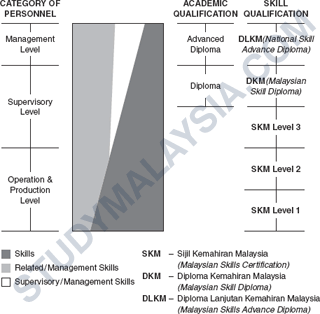
Higher Education Funding
The education at primary and secondary schools in Malaysia is free at government schools. Students studying at public universities need to pay tuition fees. However, the fees are highly subsidised by the government. Students at private institutions pay full fees.
There are many types of financial aid readily available for Malaysian students who pursue higher education in the country. These include scholarships and study loans from the public and private sectors. The government is the main provider of financial aid such as:
- The Ministry of Higher Education (Scholarship Division)
- The National Higher Education Fund (Perbadanan Tabung Pendidikan Tinggi Nasional (PTPTN), Ministry of Higher Education)
- The Public Services Department (JPA) sponsorship programme
- Various state foundations
- Government-linked companies
- Private sector and NGO - the private sector and non-government organisations (NGO) also provide funding in the form of scholarships, grants or study loans.
Fee waiver schemes are offered by many private higher educational institutions and many study loan schemes are offered by various organisations.
The biggest financial aid provider under the Ministry of Higher Education is Perbadanan Tabung Pendidikan Tinggi Nasional (PTPTN). Since its inception in 1997, PTPTN has approved loans amounting to RM38.15bil as at the beginning of 2011 with an estimated 887,995 borrowers.
Various scholarship schemes are also made available to international students through :
- The Malaysian Government on G-G arrangement
- The Ministry of Higher Education Malaysia (Scholarship Division)
- Government linked companies
- Higher educational institutions
- Other commercial organisations
(Note : For more information on financial assistance, please refer to Chapter 11.)
National Quality Assurance Agency for Higher Education - MQA
The national quality assurance agency of Malaysia is known as the Malaysian Qualifications Agency (MQA) which was established on 1 November 2007 under the Malaysian Qualifications Agency Act 2007. Its key function is to quality assure all programmes and qualifications offered by higher education providers. MQA comes under the responsibility of the Ministry of Higher Education.
MQA was established to replace the following three quality assurance agencies, namely :
- Lembaga Akreditasi Negara (established under Act 556 in 1996), for private higher educational institutions
- The Quality Assurance Division of MOHE, for public universities
- The Quality Assurance Division of MOHE, for polytechnics and community colleges
MQA is entrusted with implementing the national framework known as the Malaysian Qualifications Framework (MQF) to accredit higher educational programmes and qualifications, to supervise and regulate the quality and standard of higher education providers, to establish and maintain the Malaysian Qualifications Register and to provide for related matters.
The implementation of MQF means that there will be a unified system to bind and interlink all the qualifications awarded in Malaysia (which includes higher education qualifications and Malaysian Skills Certificates – SKM Level 1 to 5) and serve as a reference point for all Malaysian national qualifications.
MQF is an instrument that develops and classifies qualifications based on a set of criteria that are approved nationally and is at par with international good practices at the level of learning attained by the learners. This includes learning outcomes achieved and a credit system which is based on the learner's academic load. All the qualifications in the framework are based upon four classifications which are: (1) learning outcomes; (2) credit; (3) objectives; and (4) field of study.
MQF consists of eight levels of qualifications in four sectors of education.
The four sectors of education are the :
- skills sector
- vocational and technical sector
- life-long learning sector and
- higher education (university) sector
The eight levels of higher education qualifications are :
- Levels 1 to 3
These are the levels for skills certificates awarded by the skills sector; vocational and technical certificates awarded by the Vocational & Technical Sector; and certificates (Level 3) awarded by the Higher Education sector. - Levels 4 and 5
These levels are for diplomas and advanced diplomas (general degree) respectively awarded by the Technical and Vocational Sector, Skills Sector and Higher Education Sector. - Level 6 to 8
Level 6 is for the first tertiary qualification, i.e. bachelor degree with honours while Level 7 is for master degrees and Level 8 for PhD / doctoral degrees. Under the lifelong learning category, there are graduate certificates and diplomas and postgraduate certificates and diplomas.
MQA - Sectors and Qualification Levels
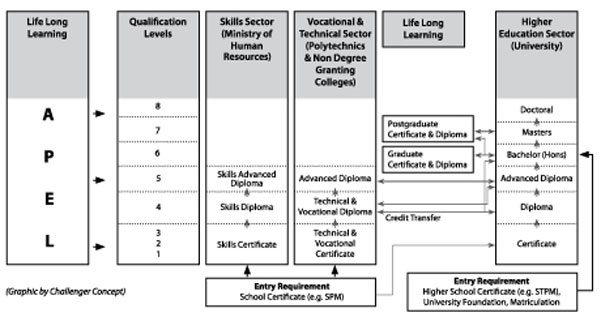
Study Pathway for Higher Education Qualifications
There are many options to acquire a tertiary qualification for SPM and STPM/pre-university qualification holders. The table below indicates the various options and study pathways at tertiary level.
Study Options - An Overview of Higher Education Routes for SPM Holders
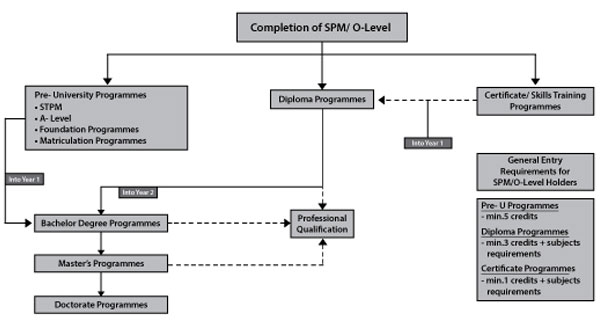
The tables below indicate the study pathways at tertiary level for SPM and STPM holders :
Study Pathway for Qualification Holders of SPM or GCSE O-Level or its equivalent

Study Pathway for Qualification Holders of STPM or GCE A-Level or its equivalent at Private HEI
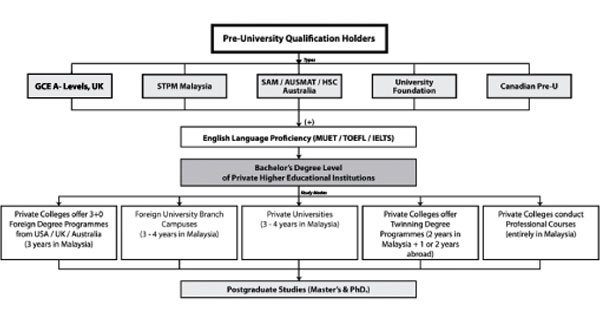
(Note : Public Universities accept STPM or MOE's matriculation certificate with MUET qualification for entry into Year 1 Bachelor's Degree.)
(Source : Education Guide Malaysia (12th Edition) published by Challenger Concept (M) Sdn Bhd)
How to Apply to Higher Educational Institutions for Undergraduate Programmes
For courses at public universities e.g. asasi (foundation studies), diploma, bachelor degree (full-time mode) for the September intake, students need to apply through the Centralised Admission Agency (UPU), Bahagian Pengurusan Kemasukan Pelajar, Jabatan Pengajian Tinggi, Ministry of Higher Education except for USM. (USM is a university with Apex status and is allowed by the ministry to recruit students directly. As such, students with pre-university qualifications who wish to pursue a bachelor's degree at USM will have to apply directly to USM.)
For courses at private higher educational institutions e.g. programmes at pre-university, diploma and bachelor degree levels, students have to apply directly to the institution of their choice. There are a few intakes per year at Private HEI.
Entry Requirements
For PHEIs
The general requirements for pre-university studies, certificate, diploma and bachelor degree programmes at PHEIs are :
| General Entry Requirements for Pre-University / Diploma / Degree Programmes at PHEIs | ||
|---|---|---|
| Education Level | General Entry Requirement | |
| University Foundation Programme | SPM/GCSE 'O' Level with 5 credits, or its equivalent | |
| Certificate Level | SPM/GCSE 'O' Level with 1 credit, or its equivalent | |
| Diploma Level | SPM/GCSE 'O' Level with minimum 3 credits, or its equivalent | |
| Year 1 Bachelor Degree | STPM/GCE A-levels + English Proficiency or its equivalent | |
For Public Universities
The general requirements for pre-university studies, certificate, diploma and bachelor degree programmes at public universities
are :
| General Entry Requirements for Pre-University / Diploma / Degree Programmes at Public Universities | |||
|---|---|---|---|
| No. | Levels of Education | General Entry Requirements | |
| 1. | University Degree Foundation Programmes /Pre-university studies |
School leavers with SPM (Sijil Pelajaran Malaysia) qualification, minimum of 5 credits | |
| 2. | Diploma Programmes | School leavers with SPM (Sijil Pelajaran Malaysia) qualification, minimum of 5 credits | |
| 3. | Bachelor Degree Programmes |
|
|
Rating of HEI
Currently there are two official rating systems for higher education institutions introduced by MoHE:
- For private colleges : MOHE has launched a rating system for private colleges in 2011, aptly known as Malaysia Quality Evaluation System (MYQUEST) which is carried out by the Department of Higher Education, MOHE.
- For public and private universities as well as university colleges in Malaysia, the Rating System for Higher Education Institutions (SETARA) has been carried out by the Malaysian Qualifications Agency (MQA).
Development Plan for Malaysian Higher Education
"Strategic Plan for Higher Education : Laying The Foundation Beyond 2020"
The most significant strategic move undertaken by MOHE in the transformation of higher education is the launch of the national higher education strategic plan on 27 August 2007.
This strategic plan, namely The "Strategic Plan for Higher Education : Laying the Foundation Beyond 2020" was formulated to meet the nation's human resource capital needs and transform higher education in order to make Malaysia an international hub of higher educational excellence. The transformation is divided into four distinct phases
- Phase 1 : Laying the Foundation (2007-2010)
- Phase 2 : Strengthening and Enhancement (2011-2015)
- Phase 3 : Excellence (2016-2020)
- Phase 4 : Glory and Sustainability (beyond 2020)
This strategic plan is designed to be broad and comprehensive and focuses on seven strategic thrusts :
- Widening access and enhancing equity;
- Improving the quality of teaching and learning;
- Enhancing research and innovation;
- Strengthening institutions of higher education;
- Intensifying internationalisation;
- Enculturation of lifelong learning; and
- Reinforcing the Higher Education Ministry's delivery system
The first part of the plan details the 'institutional pillars' that represent the initiatives by the Ministry of Higher Education in assisting all higher educational institutions in producing human capital with first-class mentality. The five pillars are :
- Governance
This applies mainly to public universities where clear definitions of parameters of responsibility for university's Board of Directors (which has replaced the University Council), Vice-Chancellors and Senates. With regard to university management reforms, the government has implemented the legal framework to transfer administrative powers to universities with increased self- governance. The public universities will be expected to be more accountable for their actions as they deliver strategic objectives that are in line with those of the ministry such as becoming more competitive, retaining the best academics and contributing significantly towards research. - Leadership
In order to achieve the transformation envisioned by the government, there is a need to : identify and define the required leadership roles at higher educational institutions; enable outstanding educational leaders to emerge; entrust key leadership roles to Chancellors; institutionalise key leadership processes in the areas of selection, development, evaluation and renewal; and develop a succession plan for a pipeline of talents. - Academia
Every higher educational institution must create an environment that fosters a culture of excellence to attract the most able staff and to enrich the local academia environment and have greater collaboration with corporations and international institutions. There must also be opportunities for career advancement and recognition of achievements. - Teaching and Learning
To introduce holistic programmes that produce confident students with a sense of balance and proportion. Their perspective should be enriched by other experiences as well. The academic staff is expected to be leaders in the field of teaching and to focus on the innovative delivery of curricula. Institutions need to have dynamic and relevant curriculum and pedagogy. Academic staff will also be expected to undergo enrichment programmes and demonstrate professionalism and competence in their ability to teach. To have multilingualism in the curriculum and the use of English in teaching and learning continues to be encouraged. The Malaysian Qualifications Framework has also been set up to benchmark the quality of higher education. - Research and Development
Efforts will be intensified to increase the number of researchers, scientists and engineers (RSE) at a ratio of 50 RSEs per 10,000 workforce. Passion and dedication towards research will also be inculcated, and increased collaboration and funding enhanced to improve R&D output e.g. commercialisation of at least 5% of R&D efforts and producing five world renowned R&D centres of excellence with the aim of creating internationally-acclaimed research universities.The second part of the National Higher Education Action Plan involves a 'critical agenda' approach designed to transform Malaysian education to become more competitive. It entails the following :
- Apex Universities
These are the nation's centres of academic distinction that will aim to achieve top global ranking. Apex universities will be given more autonomy and will have the best leaders, faculty, students and facilities so as to allow them to focus on becoming the best. The student population will reflect the plural demographic profile of the country and will be admitted based on merit. International students will make up 20% of the student enrolment. USM is the first university to be granted the Apex status. - MyBrain15
The government will accelerate the production of high-caliber human capital at the doctoral level. In doing so, it will create a pool of 100,000 high-quality graduates with doctoral degrees within the next 15 years. Top class human capital is essential to promote economic growth, trigger industrial development and explore new areas of research that can sustain a nation's competitive advantage over others. - Academic Performance Audit
All higher educational institutions will have streamlined quality assessment procedures to facilitate monitoring of quality by MOHE. An independent assessment body will focus on academic audit of the institutions. There will be a creation of a higher educational institutions rating system to rank the institutions. - Lifelong Learning
A national committee for lifelong learning will be established under the National Advisory Council on Education and Training to support the nation's human capital development needs. The government aims to increase the number of adult learners so that by 2020, 33% of the workforce will have tertiary education. The government will also establish alternatives route for access to and equity in tertiary education for rural and urban poor, taking into consideration disadvantaged individuals and communities. - Graduate Training Scheme
Opportunities will be given to students taking general courses to acquire specific career skills to prepare them for the workplace. The government will provide avenues for students to enhance their employability through training prospects which will become foundations for lifelong learning.
The third part outlines the support given in implementing the transformation of MOHE. There will a shift in the way the ministry interacts with higher educational institutions. From just being a regulator and enforcer of government policies, the ministry will also assume the role of facilitator and partner in enhancing the higher education ecosystem. The ministry plans to enhance its deliver system through the following efforts :
- Governance and management : efficiency, effectiveness and integrity
- Culture : professionalism, high performance and teamwork
- Financial resources : efficient allocation in achieving objectives
- Human resources : synergy of new, existing and old expertise
- Info-structure : timely availability of information and analysis
To implement these changes, a programme governance structure has been outlined by the ministry. Part of the agenda includes project and programme management best-practices. The programme structure involves a steering committee that reports to MOHE.
The steering committee will consist of representatives from other ministries, higher educational institutions, the corporate sector and eminent scholars. Assisting the steering committee is an advisory panel and to drive and spearhead the transformation is the Programme Management Office. The Programme Management Office will consist of a Programme Management Director and four units viz. project delivery unit, process and monitoring unit, monitoring and reporting unit, and communication unit.
Project teams will also be put together to carry out the planning and design of a specific initiative which could be a pillar or a critical agenda programme. Led by a project manager, the team will comprise individuals from various institutions and agencies, consultants and other experts.
At the higher education institution level, mini Project Management Offices will also be implemented to provide support for implementation planning and execution.
Summary
All stakeholders have shown high commitment in the first phase of NHESP through the implementation of various initiatives that are geared towards achieving pre-determined performance measures. Twenty Critical Agenda Projects were identified and carried out throughout this phase. They include :
- Governance
- Leadership
- Academia
- Teaching and learning
- Research and development
- Internationalisation
- Industry-Academia
- Graduate employability
- Private higher education institutions
- Holistic student development
- Quality assurance
- Transformation of polytechnics
- Accessibility and sustainability
- MyBrain 15
- APEX
- e-Learning
- The delivery system of MOHE
- Lifelong learning
- Top business school
- Centre of Excellence
- Entrepreneurship
- Transformation of community colleges
The implementation of the National Higher Education Strategic Plan (NHESP) Phase 1 from 2007-2010 has built a solid foundation for all stakeholders of higher education in terms of increasing the quality of human capital that is able to meet the challenges of economic development. This phase has prepared the ground for systemic changes necessary to the fulfillment of long-term plans for higher education.
At the end of Phase 1 in December 2010, 22 CAPs had been implemented. For Phase 2 (2011-2015), the Minister of Higher Education announced an additional CAP, i.e. the 'Knowledge Transfer Programme', bringing the number of Phase 2 CAPs to 23.
NHESP Phase 2 (2011-2015) : Strengthening and Enhancement
Phase 2 of the NHESP has been designed as a result of discussions and negotiations between every CAP project team to ensure the success of the planned agenda. The Action Plan for Phase 2 is closely linked to the achievements of each CAP implemented in Phase 1 and the overall key objectives of the "National Higher Education Strategic Plan Beyond 2020".There are improvements of the NHESP by taking into consideration recent government policies, with specific reference made to the following documents :
- Tenth Malaysia Plan (10MP)
- Malaysian Economic Model
- Government Transformation Programme Roadmap (GTP)
- Economic Transformation Program (ETP): A Roadmap for Malaysia
In Phase 2, the seven core thrusts (in Phase 1) continue to be emphasized in the plan. All 23 CAP planned for Phase 2 play a role in the achievement of the seven core objectives. In other words, performance and outstanding achievement for all CAPs is imperative in the achievement of all the core thrusts.
During the launch of Phase 2, the Minister of Education highlighted the focus for this stage, i.e.
- Strengthening efforts to produce human capital
- Enriching creativity and innovation
- Maximizing the ecosystem of higher education
- Taking advantage of globalisation
- Transforming leadership among the leading institutions of higher learning
On the efforts to produce human capital, the plan will focus on strengthening of the 5C's in the development of talent among students which was launched by the ministry previously. The 5C's are: critical thinking and problem solving, effective communication skills, collaboration and team building, creative and innovative, and culturally literate. The development of human capital will also focus on enhancing intellectual capital.
Research, development and innovation aimed at increasing knowledge, discovery and commercialisation of new products will also be a priority in Phase 2. Among the steps that will be taken to boost R&D and innovation are to encourage a pioneer mindset among researchers; encourage innovative research in line with the requirements of nation; translate findings to products or platforms that can be commercialised; and enrich the knowledge repository of the country.
All five research universities have been instructed to intensify efforts to spearhead high-impact research platforms. Under the 10MP, research funds such as the Fundamental Research Grant Scheme (FRGS), Exploratory Research Grant Scheme (ERGS), Long-Term Research Scheme (LRGS) and Prototype Development Research Grant Scheme (PRGS) are expected to enliven the landscape of R&D and increase commercialisation.
In the context of the Higher Education Centre of Excellence (HiCOE), more HiCOE will be established on the basis of mutual understanding and collaboration. The six existing HiCOE should also begin collaboration with world renowned research institutes during this phase. Meanwhile, the role of Malaysia's Top Business School (TBS) will be doubled. The corporatisation of TBS is the newest element in strengthening its role. The niche unique to TBS in Malaysia is the emphasis on the development of 'human governance'. At the same time, MOHE will assess several business schools to be upgraded as TBS by 2015.
MOHE has acknowledged the role of PHEIs in developing the potential of the nation. As such, the collaboration between public and private institutions should be intensified particularly in research, development and commercialisation as well as the sharing of best practices in terms of corporate management, income generation and others. PHEIs need to be restructured such that they do not rely on student tuition fees alone as a source of income. Alternative income through R&D&C, executive programmesand other academic services need to be explored.
The Way Forward
The tremendous growth of the Malaysian higher education sector over the last two decades has helped to put Malaysia on the international playing field in terms of providing higher education to the increasing number of both Malaysian and international students. It has also contributed towards the intensifying of research in this region.
The "Strategic Plan for Higher Education : Laying the Foundation Beyond 2020" outlines the measures and strategies that will continue to make Malaysia an international centre of educational excellence. Further, in order to secure a better future for Malaysia in this globalised and ever-changing world, the Ministry of Higher Education has outlined several priorities that will be implemented over the next 10 years. The government has clearly outlined the strategic thrusts in this strategic plan to make Malaysia an international centre of educational excellence by 2020. Among the top aims are to ensure that Malaysians will have greater access to quality higher education that is affordable. This will be achieved by optimising the resources of existing public and private higher education institutions. In addition, higher education institutions such as polytechnics and community colleges will be upgraded to shed the image that such institutions offer merely skill-based courses.
It is hoped that greater access to higher education will result in a larger proportion of the younger generation that are dynamic and progressive. The Ministry hopes that the next generation will be daring enough to face challenges, take risks, and learn to embrace adventure and exploration. HEIs have the task of producing graduates of high quality who will have a high level of employability. The curriculum produced by the institutions of higher learning needs to be in line with the needs of the global marketplace.
The ministry also plans to intensify investments in science and technology and increase the potential and credibility of the country's research centres. Malaysia aims to be a centre of excellence for knowledge and innovation as well as gain international presence. The government has identified the need for the knowledge-economy to fuel the growth of the nation. Substantial investment is required in knowledge-intensive activities such as R&D, licensing and intellectual property. Malaysian internationalisation-friendly policies have successfully convinced a number of reputable foreign universities to set up branch campuses or faculties in the country as well as many international students have Malaysia a preferred choice. MOHE has launched the Internationalisation Policy for Higher Education in 2011. This initiative aims to accelerate the inflow of international students into the country.
Conclusion
The well structured higher education system in Malaysia is key in enabling the government to achieve its aspirations to have a resilient nation, encourage the creation of a just society, maintain sustainable economic growth, develop global competitiveness, build a K-economy and innovative culture, strengthen human resource development and maintain sustainable environmental development.
The efforts of the government and education entrepreneurs to constantly enhance and improve the infrastructure of higher education, human resource development, and curricula in order to provide better quality education for students have earned the country international recognition. Malaysia has also been recognised for its success in the democratisation of higher education.
References
• Education Guide Malaysia (12th Edition)
• Study in Malaysia Handbook (8th International Edition)
• "National Strategic Plan For Higher Education: Laying The Foundation Beyond 2020", by MOHE
• National Strategic Plan For Higher Education: Phase 1 & Phase 2
• 'The Way Forward' (2011), by Private Higher Education Management Sector
• jpt.moe.gov.my / Malaysia Higher Education Statistics 2011
• www.mqa.gov.my
Useful Charts
• Appendix 3 provides the organisation structure of the Ministry of Higher Education Malaysia - Apex Universities
You May Also Be Interested In...
Discovering study modes for a bachelor degree (home-grown and foreign degree)
![Discovering study modes for a bachelor degree (home-grown and foreign degree) - StudyMalaysia.com]() Both public and private higher educational institutions offer bachelor...
Both public and private higher educational institutions offer bachelor...A Glance At The Malaysian Education System
![A Glance At The Malaysian Education System - StudyMalaysia.com]() Children in Malaysia begin their education as early as at the age of f...
Children in Malaysia begin their education as early as at the age of f...The Malaysian Higher Education System - An Overview
![The Malaysian Higher Education System - An Overview - StudyMalaysia.com]() A Snapshot of Higher Education Institutions in Malaysia The higher ed...
A Snapshot of Higher Education Institutions in Malaysia The higher ed...Deciding Where And What To Study
![Deciding Where And What To Study - StudyMalaysia.com]() “Your best years in education are those spent in college or universi...
“Your best years in education are those spent in college or universi...Private Education Route for Bachelor's Degree Programmes and Professional Qualifications
![Private Education Route for Bachelor's Degree Programmes and Professional Qualifications - StudyMalaysia.com]() From the early 1980s, Malaysian private colleges pioneered in the prov...
From the early 1980s, Malaysian private colleges pioneered in the prov...Pathways to higher education in Malaysia
![Pathways to higher education in Malaysia - StudyMalaysia.com]() The following diagram gives you an overview of study options for stude...
The following diagram gives you an overview of study options for stude...
















